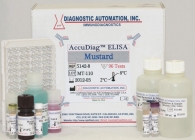
ELISA Kits
- • Anemia ELISA kits
- • Allergy ELISA kits
- • Autoimmune Disease kits
- • Bone Metabolism ELISA kits
- • Blood bank ELISA kits
- • Cancer ELISA kits
- • Cardiac Markers ELISA kits
- • Diabetes Assays ELISA kits
- • Drug test ELISA kits
- • Fertility ELISA kits
- • Food ELISA kits
- • Infectious Disease ELISA kits
- • Other ELISA Kits
- • Parasitology ELISA kits
- • Steroid ELISA kits
- • Thyroid ELISA kits
Rapid Tests
- • Allergy Rapid tests
- • Bone Metabolism
- • Cancer Rapid tests
- • Cardiac markers Rapid tests
- • Drug Tests
- • Fertility Rapid tests
- • Hepatitis Panel
- • Infectious Disease & other tests
- • Other
- • Ovulation Rapid tests
- • Pregnancy tests
- • Urine Reagent Strips tests
IFA Kits
Chemiluminescence Immuno Assays
- • Allergy Assays
- • Autoimmune Thyroid Assays
- • Cardio-Vascular Monitoring
- • Diabetes Assays
- • Fertility Assays
- • Growth Deficiency
- • Infectious Disease Assays
- • Others
- • Steroid Assays
- • Thyroid Assays
- • Tumor Marker Assays
Serology Tests
- • ASO (Anti-Streptolysin-O)
- • CRP (C-Reactive Protein)
- • Mono (Infectious Mononucleosis)
- • RF (Rheumatoid Factor)
- • RPR (Rapid Plasma Reagin)
- • SLE (Systemic Lupus Erythematosus)
Instrumentation



Mustard ELISA Kit
| Name |
Mustard ELISA Test |
|---|---|
| Full name |
Food Mustard ELISA Test Kit |
| Test | 96 |
| Method | ELISA method: Enzyme Linked Immunosorbent Assay |
| Principle | ELISA principle- Peroxidase conjugated |
| Detection Range | Qualitative elisa assay- Positive, Negative Controls |
| Sensitivity | 1 ppm |
| Total Time | 60 min. |
 |
 |
 |
Mustard ELISA Kit description:
Diagnostic Automation Inc. offers a Mustard ELISA Kit that is an Enzyme Immunoassay for the Quantitative determination of Mustard in food. This Mustard ELISA Kit is a rapid and sensitive Food Allergen ELISA Kit which is designed to provide a sensitive and convenient method for screening food samples for mustard residues. The Mustard ELISA Kit represents a highly sensitive Food Allergen ELISA Kit detection system for yellow mustard and is particularly capable of the quantification of resides in sausage, dressings, soups, cheese, and mixed herbs.
Materials Provided with Mustard ELISA Test Kit:
1. Microtiter plate: 12 strips with 8 breakable wells coated with anti-mustard antibodies
2. Mustard Standards (0; 2; 6; 20; 60 ppm of mustard): 5 vials with 1.0 mL each
3. Conjugate (anti-mustard-peroxidase): 15 mL
4. Substrate Solution (TMB): 15 mL
5. Stop Solution (0.5 M H2SO4): 15 mL
6. Extraction and sample dilution buffer (Tris): 2 x
7. Washing Solution (PBS + Tween 20): 60 mL as 10x
8. Plastic bag to store unused microtiter strips.
9. Instruction Manual
Materials required but not provided:
1. Freshly distilled or deionized water
2. Dispensing system and/or pipette
3. EIA kit Microplate washer
4. EIA kit Microplate Reader with 450nm wavelength
Mustard ELISA Test Kit Background Information:
Mustard belongs to the Brassica plants. With about 30-35%, the fraction of proteins in mustard seed is very high. Some of these proteins are known for being allergenic, such as Sin a 1 and Bra j 1. These proteins are predominantly heat resistant making them stable to different production processes. In addition to brown mustard (Brassica juncea) and black mustard (Brassica nigra) primarily yellow mustard (Sinapsis alba) is used as an ingredient in many foods and food preparations. For mustard allergic persons, hidden mustard allergens in food are a critical problem. Already very low amounts of mustard can cause allergic reactions, which may lead to anaphylactic shock in severe cases. Because of this, mustard allergic persons must strictly avoid the consumption of mustard or mustard containing food. Cross-contamination, mostly in consequence of the production process, is often noticed. The sausage production process is a representative example. This explains why in many cases the existence of mustard residues in food cannot be excluded. For this reason sensitive detection systems, like this Mustard ELISA Kit, for mustard residues in foodstuffs are required.
Mustard ELISA Kit Test Principle:
The Mustard ELISA Kit is a quantitative test based on the principle of the enzyme linked immunosorbent assay. An antibody directed against mustard proteins is bound on the surface of a microtiter plate.
Diagnostic Automation Inc offers several popular Food Allergen ELISA Kits: Egg Protein Residue in Food ELISA Kit, Soy Protein Residue Detection in Food ELISA Kit, Lupine ELISA Kit, Peanut ELISA Kit, Soy ELISA Kit, Almond ELISA Kit, Gluten ELISA Kit, Walnut ELISA Kit, and Milk Protein Residue Detection in Food ELISA Kit. For more information on any of these Food ELISA Test Kits please see our website home page, or contact our Customer Service Representative at 818-591-3030.
Product Note:
The limit of detection (LOD) of this Mustard ELISA test is 1 ppm. The limit of quantification (LOQ) of the DAI Mustard test is 2 ppm. Due to the variety of sample matrices and their influence on the blank, results less than the LOQ should be treated as negative.
ELISA kits - Rapid tests- Drug tests- Pregnancy test - IFA kits - CLIA assays - Serology tests - Instrumentation
©1992 Diagnostic Automation/Cortez Diagnostics Inc. All rights reserved.


 Peanut ELISA kit
Peanut ELISA kit
 Egg White In Food ELISA Kit
Egg White In Food ELISA Kit
 Hazelnut ELISA kit
Hazelnut ELISA kit
 Walnut ELISA kit
Walnut ELISA kit
 B-Lactoglobulin ELISA Kit
B-Lactoglobulin ELISA Kit 








